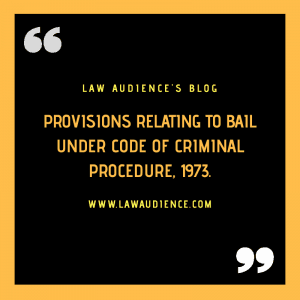CREATION OF THE TRUSTS RULES AND DUTIES & LIABILITIES OF THE TRUSTEES UNDER THE INDIAN TRUST ACT, 1882[1]
INTRODUCTION:
The Indian Trusts Act, 1882 is an Enactment in India correlated to separate guardians and custodians. The Act describes what would legally be designated as a Trust[2] and who can be authorized its trustees and provides the explanation for them[3]. A Trust is a commitment attached to the possession of premises and emerging out of reliance reclined in and admitted by the owner for the interest of another.
A Trustee is a person who accepts the Confidence & the person for whose advantage the trust is admitted is called the Beneficiary[4].
Keywords: Enactment, Trustee, Trust, Possession, Beneficiary.
DIVISIONS OF THE TRUST:
1. PUBLIC TRUST:
An Unrestricted trust is formulated for spiritual & charitable objectives or for social advancement. This trust cannot be used to shift wealth to your recipient. No approved agreement needed for generating a public trust. The trust designed for the elevation of knowledge, the progression of public wellness, relaxation of hunger, considered as generous in law as a public charitable trust. Public philanthropic trust must be formulated for the interest of the public. The donation has been in the Convergent list of the Constitution, both the centre and the state the right to constitute over public generous guarantees. A public generous organization can be settled by enrolling as a trust by accomplishing a trust deed.
2. PRIVATE TRUST:
A private trust is used to assign the property to your beneficiaries these trusts must be imperatively designed & enrolled & administered under the Indian Trusts Act, 1882. It is formulated for the commercial profit of one or more selected recipients rather than for the public advantage.
LIABILITIES OF TRUSTEES:
The most significant features of a Trustee’s obligations are its legal guardian persona. A Trustee is legitimately and substantially secured to administer the trust assets in a reliable and prolific method and is beneath an imperative commitment to act completely for the interest of the Trust’s pensioners. Trustees are legally bound to accompany the terms of the organization and are answerable to the successors for their operations. They may be endured individually accountable if they are discovered to be dealing on their own terms & conditions without following the code of conduct of the respective Trusts or exercising trust property for their personal interest. A trustee handles resources which are retained in the organization. A trust is a grouping in which one personage contains the premises of different for the advantage of a third individual called as heir. The beneficiary is ordinarily the proprietor of the premises or a person assigned as the recipient by the proprietor of the premises.
DUTIES OF TRUSTEES:
Foundation legal Guardian is the backbones who distribute last engagement for administering philanthropy and instructing how it is controlled and operated. They may be described as Trustees, the committee, the administration panel, administrators, managers or something else. This leadership demonstrates what being a trustee concerns & what they do. The Trustee serves as the authorized possessor of Trust property and is effective for managing any of the assets held in the organization it also incorporates the responsibility of filings of Tax on behalf of the trust and categorizing the assets as per the conditions of the Trust. Both duties must be accomplished with the accordance of the law.
AMENDMENT TO TRUSTEES ACT:
The pursuance of the long-pending recommendation of the 17th Law Commission Report 1961, the Amendment Act was passed to amend Section 20 of the Act with the intention to provide trustees with greater autonomy and flexibility to take decisions on the investment of trust money; enable the Central Government to notify securities or class of securities for investment by trusts and remove outdated provisions. The Parliament removed the first seven categories, retaining only the amended version of the said 8th category. Section 20 now provides that trustees can invest the surplus trust money “in any of the securities or class of securities expressly authorized by the instrument of trust or as specified by the Central Government, by notification in the Official Gazette”[5].
SECTION 68 (LIABILITY OF BENEFICIARY JOINING IN BREACH OF TRUST):
The obligation of successor participating in Breach of Trust
Where one of the numerous Beneficiaries:
(1) Associates in engaging the infringement of Trust.
(2) Intentionally receives any interest therefrom, externally the acquiescence of the different heirs.
(3) Enhances knowledgeable of a transgression of an organization performed or expected to be perpetrated, and either really secretes it or does not within a fair time take proper measures to defend the concerns of the other grantees.
(4) Should lie the legal guardian and thereby provoked him to perpetuate an infringement of trust[6].
BENAMI TRANSACTIONS:
In the Landmark case of R.Rajagopal Reddy v. Padmini Chandrasekharan The Hon’ble apex court held that “Benami transactions were a recognized species of legal transactions pertaining to immovable properties”[7].
CONCLUSION:
Where an infringement of trust has happened and an individual other than a Trustee has accepted the advantage from the transgression, he will be necessitated to reimburse the administrator. Such compensation is not accessible to a trustee who has been condemned of deception in violation of trust. A Trustee has the license to do all such actions that are rational & peculiar for the consummation, assurance or profit of the trust assets & also for the reassurance of a pensioner who is not accountable to contract. The achievement of the sale may demand specific conventionalities.
[1] AUTHORED BY: MR. AVINASH PANDEY, B.B.A.LL.B, 2ND YEAR STUDENT AT IFIM LAW COLLEGE & RESEARCH WRITER AT LAW AUDIENCE: EDITED BY: MR. VARUN KUMAR (FOUNDER & CEO & EDITOR-IN-CHIEF).
[2] Section 4, The Indian Trust Act, 1882, No. 2, Acts of Parliament, 1882 (India).
Lawful Purpose: A trust may be created for any lawful purpose. The purpose of a trust is lawful unless it is (a) forbidden by law, or (b) is of such a nature that, if permitted, it would defeat the provisions of any law, or (c) is fraudulent, or (d) involves or implies injury to the person or property of another, or (e) the court regards it as immoral or opposed to public policy. Every trust of which the purpose is unlawful is void. And where a trust is created for two purposes, of which one is lawful and the other unlawful, and the two purposes, cannot be separated, the whole trust is void.
Explanation: In this section, the expression “law” includes, where the trust property is immovable and situate in a foreign country, the law of such country.
[3] Section 10, The Indian Trust Act, 1882, No. 2, Acts of Parliament, 1882 (India).
Who May Be Trustee: Every person capable of holding property may be a trustee; but, where the trust involves the exercise of discretion, he cannot execute it unless he is competent to contract.
No one bound to accept trust: No one is bound to accept a trust.
Acceptance of trust: A trust is accepted by any words or acts of the trustee indicating with reasonable certainty such acceptance.
Disclaimer of trust: Instead of accepting a trust, the intended trustee may, within a reasonable period, disclaim it, and such disclaimer shall prevent the trust-property from vesting in him. A disclaimer by one of two or more co-trustees vests the trust-property in the other or others and makes him or them sole trustee or trustees from the date of the creation of the trust.
[4] Section 3, The Indian Trust Act, 1882, No. 2, Acts of Parliament, 1882 (India).
[5] Rishabh Shroff & Kunal Savani, Amendment To The Indian Trusts Act (Oct. 12, 2018, 10:00 PM), http://www.legaleraonline.com/articles/amendment-to-the-indian-trusts-act.
[6] Section 68, The Indian Trust Act, 1882, No. 2, Acts of Parliament, 1882 (India).
[7] In the Case of R.Rajagopal Reddy v. Padmini Chandrasekharan on 31 January 1995 (India).
Under the Indian Trusts Act, 1882 almost 113 years back the then legislature enacting the law laid down in Section 82 as under: “Transfer to one for consideration paid by another where property is transferred to one person for a consideration paid or provided by another person, and it appears that such other person did not intend to pay or provide such consideration for the benefit of the transferee, the transferee must hold the property for the benefit of the person paying or providing the consideration.



